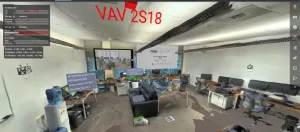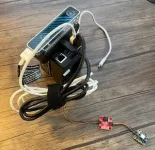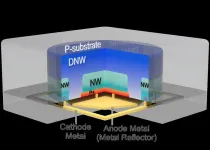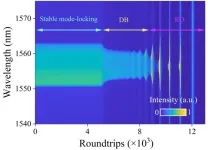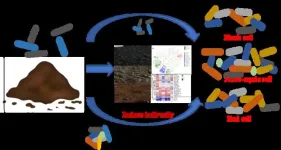(Press-News.org) A new system that brings together real-world sensing and virtual reality would make it easier for building maintenance personnel to identify and fix issues in commercial buildings that are in operation. The system was developed by computer scientists at the University of California San Diego and Carnegie Mellon University.
The system, dubbed BRICK, consists of a handheld device equipped with a suite of sensors to monitor temperature, CO2 and airflow. It is also equipped with a virtual reality environment that has access to the sensor data and metadata in a specific building while being connected to the building’s electronic control system.
When an issue is reported in a specific location, a building manager can go on-site with the device and quickly scan the space with the Lidar tool on their smartphone, creating a virtual reality version of the space. The scanning can also occur ahead of time. Once they open this mixed reality recreation of the space on a smartphone or laptop, building managers can locate sensors, as well as the data gathered from the handheld device, overlaid onto that mixed reality environment.
The goal is to allow building managers to quickly identify issues by inspecting hardware and gathering and logging relevant data.
“Modern buildings are complex arrangements of multiple systems from climate control, lighting and security to occupant management. BRICK enables their efficient operation, much like a modern computer system,” said Rajesh K. Gupta, one of the paper’s senior authors, director of the UC San Diego Halicioglu Data Science Institute and a professor in the UC San Diego Department of Computer Science and Engineering.
Currently, when building managers receive reports of a problem, they first have to consult the building management database for that specific location. But the system doesn’t tell them where the sensors and hardware are located exactly in that space. So managers have to go to the location, gather more data with cumbersome sensors, then compare that data against the information in the building management system and try to deduce what the issue is. It’s also difficult to log the data gathered at various spatial locations in a precise way.
By contrast, with BRICK, the building manager can directly go to the location equipped with a handheld device and a laptop or smartphone. They will immediately have access on location to all the building management system data, the location of the sensors and the data from the handheld device all overlapping in one mixed reality environment. Using this system, the operators can also detect faults in the building equipment from stuck air-control valves to poorly operating handling systems.
In the future, researchers hope to find CO2, temperature and airflow sensors that can directly connect to a smartphone, to enable occupants to take part in managing local environments as well as to simplify building operations.
A team at Carnegie Mellon built the handheld device. Xiaohan Fu, a computer science Ph.D. student in the research group of Rajesh Gupta, director of the Halicioglu Data Science Institute, built the backend and VR components that build upon their earlier work on BRICK metadata schema that has been adopted by many commercial vendors.
Ensuring that the location used in the VR environment was accurate was a major challenge. GPS is only accurate to a radius of about a meter. In this case, the system needs to be accurate within a few inches. The researchers’ solution was to post a (few) AprilTags–similar to QR codes —in every room that would be read by the handheld device’s camera and recalibrate the system to the correct location.
“It’s an intricate system,” Fu said. “The mixed reality itself is not easy to build. From a software standpoint, connecting the building management system, where hardware, sensors and actuators are controlled, was a complex task that requires safety and security guarantees in a commercial environment. Our system architecture enables us to do it in an interactive and programmable way.”
The team presented their work at the BuildSys 23 Conference on Nov. 15 and 16 in Istanbul, Turkey.
The work was sponsored by the CONIX Research Center, one of the six centers in JUMP, a Semiconductor Research Corporation program sponsored by DARPA.
Debugging buildings with mixed reality
Xiaohan Fu, Rajesh K. Gupta, University of California San Diego
John Pedraza, Anthony Rowe, Carnegie Mellon University
BRICK Consortium:
brickschema.org
END
Bringing together real-world sensors and VR to improve building maintenance
2024-01-31
ELSE PRESS RELEASES FROM THIS DATE:
Potential link between high maternal cortisol, unpredicted birth complications
2024-01-31
PULLMAN, Wash. – A snippet of hair can reveal a pregnant person’s stress level and may one day help warn of unexpected birth problems, a study indicates.
Washington State University researchers measured the stress hormone cortisol in hair samples of 53 women in their third trimester. Of that group, 13 women who had elevated cortisol levels later experienced unpredicted birth complications, such as an early birth or hemorrhaging.
While more research is needed with larger groups, this preliminary finding could eventually lead to a non-invasive way to identify those ...
Virtual reality treatment for palliative care shown to help patients ‘flourish’ during relaxation therapy
2024-01-31
Palliative care is the interdisciplinary medical specialty of caring for people with serious and often terminal illnesses. Its aim is to improve quality of life for such patients and their families, by relieving symptoms and stress. Palliative care is widely considered to be a human right, even if the World Health Organization estimates that only 14% of the approximately 56.8 million people who need it each year worldwide actually receive it. Since seriously ill patients often experience stress, psychological interventions such as relaxation therapy play an important role in palliative care.
Now, researchers have shown in a ground-breaking clinical trial ...
Antiviral color nanocoating technology
2024-01-31
Since the onset of COVID-19, we've become accustomed to seeing antiviral films attached to elevator buttons and public transportation handles. However, conventional antiviral films are made by mixing antiviral metal particles with polymers. Due to the manufacturing process, only a very small fraction of these metal particles is exposed on the surface. As a result, contrary to the belief that these films will protect us from viruses, the actual antiviral effect upon contact with the film surface is not ...
Key LiDAR sensor elements for autonomous vehicles are now made with our technology
2024-01-31
LiDAR sensors are indispensable for the realization of advanced technologies such as advanced driver assistance systems (ADAS), autonomous driving, and AR/VR. In particular, short- and mid-range LiDAR used in AR/VR devices and smartphones requires better distance (depth) resolution to detect the shape of a person or object more accurately, and so a single-photon detector with better timing jitter performance is required.
LiDAR measures distance and creates a 3D image by calculating the time it takes for a photon emitted by the transmitter to strike an object, reflect, and arrive back at the ...
Dissipative soliton vanishes, breathing dynamics occur
2024-01-31
Solitons are quasiparticles that propagate along a non-dissipative wave. Put another way, they are waveforms that hold their shape as they move—like a single wave moving across the surface of a pond. They can also show the particle-like behavior, such as collision, attraction, and repulsion. Ultrafast fiber laser is an ideal platform to explore nonlinear dissipation dynamics, but also deepen the understanding of optical soliton properties. In dissipative system, dissipative soliton can be obtained due to the balance between nonlinearity and ...
American Heart Month 2024 brings renewed focus on CPR, urgent need for Nation of Lifesavers™
2024-01-31
DALLAS, Jan. 30, 2024 — A new survey conducted by the American Heart Association, which is marking one hundred years of service saving lives, suggests that increased visibility of the need for CPR has had a positive impact on someone’s willingness to respond if they are bystanders in a cardiac emergency. However, there remains a significant gap in awareness that emphasizes the urgent need for collaboration between governments, communities, businesses and the media to promote and provide lifesaving training. To help close this gap, the ...
Fluvo-aquic soil treated with pig manure present a higher risk of antibiotic-resistant bacteria than black and red soils
2024-01-31
In agroecosystems where manure is applied as organic fertilizer, these antibiotic residues exert strong selective pressure on soil microbial communities. Antibiotic-resistant bacteria (ARB) from animal manure would increase the concentration of ARB in soils. The influencing mechanisms of soil types on the distribution of ARB were worthy of further exploration. This study demonstrates that CTC-manure induced more resistance of soil indigenous microbes in fluvo-aquic soil, Lactobacillus, Dyella, Ralstonia, and Bacillus ...
Black summer bushfires in Australia wiped $2.8 billion from tourism supply chain
2024-01-31
A first of its kind study of the 2019-2020 ‘Black Summer’ bushfires in Australia has revealed that the tourism industry nationwide took an immediate hit of $2.8 billion in total output to its broader supply chains and almost 7300 jobs disappeared nationwide.
The fires four years ago triggered widespread tourism shutdowns in many parts of the country in the lead up to the peak Christmas and New Year season, resulting in $1.7 billion direct losses to the tourism industry, which triggered the larger drop in supply chain output.
“These results are an illustration of what can be expected in the future not only in Australia, but in other ...
Using computers to design proteins allows researchers to make tunable hydrogels that can form both inside and outside of cells
2024-01-31
When researchers want to study how COVID makes us sick, or what diseases such as Alzheimer's do to the body, one approach is to look at what's happening inside individual cells.
Researchers sometimes grow the cells in a 3D scaffold called a "hydrogel." This network of proteins or molecules mimics the environment the cells would live in inside the body.
New research led by the University of Washington demonstrates a new class of hydrogels that can form not just outside cells, but also inside of them. The team created these hydrogels from protein building blocks designed using a computer to form a specific structure. These hydrogels exhibited similar mechanical properties ...
BIPOC individuals bear greater post-COVID burdens
2024-01-31
A study study published today reports that BIPOC individuals who were infected with COVID-19 experienced greater negative aftereffects in health and work loss than did similarly infected white participants.
Despite similar symptom prevalence, Hispanic participants compared to non-Hispanic participants and BIPOC participants compared to white participants had more negative impacts following a COVID-19 infection in terms of health status, activity level and missed work, the authors wrote.
The findings appeared in the journal Frontiers ...
